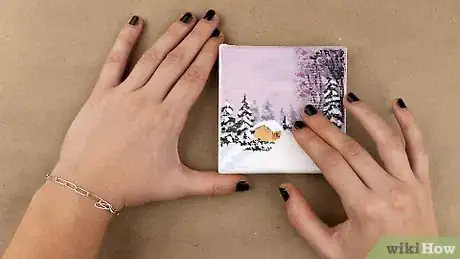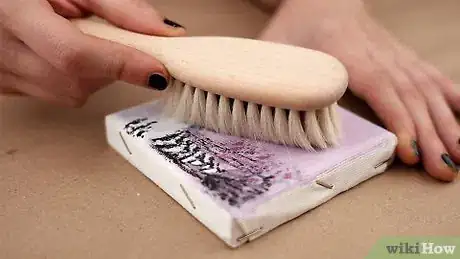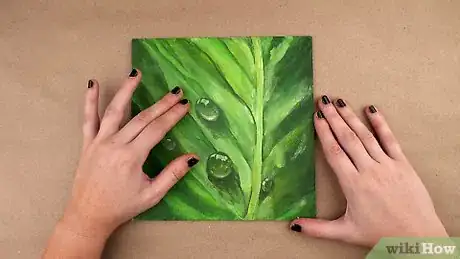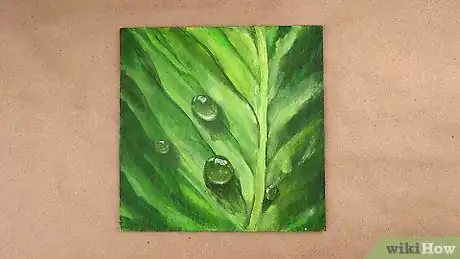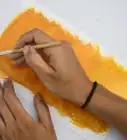This article was co-authored by Kelly Medford. Kelly Medford is an American painter based in Rome, Italy. She studied classical painting, drawing and printmaking both in the U.S. and in Italy. She works primarily en plein air on the streets of Rome, and also travels for private international collectors on commission. She founded Sketching Rome Tours in 2012 where she teaches sketchbook journaling to visitors of Rome. Kelly is a graduate of the Florence Academy of Art.
There are 9 references cited in this article, which can be found at the bottom of the page.
This article has been viewed 74,068 times.
These days, it’s becoming increasingly common for artists to use water-based acrylic paints in their pieces. Because of their softer texture, however, these paints have a tendency to attract dust and dirt and hold them in place. In order to properly maintain a collection of acrylic paintings, it’s essential to know the best way to clean them without damaging the medium. Usually, a gentle dusting or wipe down will be enough to touch up most acrylic paintings. Use a soft brush or a mild soap solution to clean your art, then see that it’s stored properly to preserve its original beauty for years to come.
Steps
Removing Dust from an Acrylic Painting
-
1Make sure the paint is dry. The most important thing to keep in mind when preparing to clean an acrylic painting is that the paint must be completely dry. If it’s still wet, you may smudge the outermost layer of paint, dulling the colors and wearing down distinctive features, such as the artist’s brushstrokes. Once acrylic paint has cured, you can carefully clean the outer surface without worrying about causing damage.[1]
- Wait at least 24 hours before attempting to clean newly-completed paintings.
- The slightest blemish on an original piece of artwork may be enough to depreciate its value.
-
2Purchase a soft-bristled brush. Look for a brush with a wide base and fine bristles made from natural materials like hair. You can use this tool to whisk away loose dirt and debris clinging to the acrylic paint. In many cases, a good dusting every now and then is all a painting will need to keep it in good condition.[2]
- A makeup brush or hand duster will work well for this purpose.
- The brush should be clean and dry before it comes into contact with the acrylic painting.[3]
Advertisement -
3Brush off the surface of the painting. Go over the exterior of the painting lightly using long, fluid strokes. Work from one of the upper corners of the painting across and down until you’ve dislodged all visible dust and dirt. Be careful not to apply too much pressure, as this may leave behind marks on the soft acrylic.[4]
- Don’t forget to address dust that’s built up on the frame or surrounding surfaces, as well.[5]
- To remove a heavier layer of dust, hold a vacuum cleaner hose close to the painting as you brush it.
-
4Dust your paintings regularly. Acrylic paintings should be dusted thoroughly every couple of months. This is especially important if the painting is being stored or displayed in a private residence or somewhere else that doesn’t provide the benefits of highly-regulated storage conditions. Frequent dusting will reduce the chances of dirt being absorbed into the acrylic paint as it undergoes textural changes.[6]
- When it comes to preserving works of art, prevention is always more effective than cleaning.[7]
EXPERT TIPTry a soft cloth if you don't have a duster.
Kelly Medford is an American painter based in Rome, Italy. She studied classical painting, drawing and printmaking both in the U.S. and in Italy. She works primarily en plein air on the streets of Rome, and also travels for private international collectors on commission. She founded Sketching Rome Tours in 2012 where she teaches sketchbook journaling to visitors of Rome. Kelly is a graduate of the Florence Academy of Art.
Kelly Medford
Professional Painter Kelly Medford
Kelly Medford
Professional Painter
Cleaning the Painting with Soap and Water
-
1Be aware of the risks of cleaning the painting yourself. Even though they’re less temperamental than other types of paint, acrylics can still be ruined with inappropriate materials and techniques. Before you employ DIY cleaning methods, understand that tampering with a painting may ultimately lower its value.[8]
- Consider having valuable works cleaned professionally by a qualified art restorer. Though it will cost more, you’ll be able to rest assured that the painting is receiving proper treatment.
- Never use harsh chemicals or abrasive tools to clean a painting. This includes traditional substances such as mineral spirits and turpentine as well as commercial cleaners.
-
2Combine soap and water in a large container. Fill a sink or bucket with clean, warm water. Add a few drops of a non-astringent liquid dish detergent and stir the mixture by hand until it forms a mild solution. You can use this solution to spot-clean cured acrylic paintings.[9]
- The detergent will help emulsify dirt and grime to lift them from the surface of the paint while the water flushes them away.
-
3Dampen a cloth or sponge. For best results, use a cloth made from a soft material like cotton or microfiber. Saturate the cloth with the soap solution, then wring out as much excess water as possible. If you’re using a sponge, give it a good shake before you begin. It should just barely be damp.
- Make sure there’s no heavy soap residue on the cleaning cloth.
- Some types of acrylic paint are water-soluble. If there is too much moisture in the cloth, it may begin to dissolve the paint, creating a blotchy, fuzzy appearance.[10]
-
4Wipe down the painting carefully. Go over the painting with long, smooth strokes from top to bottom and from side to side. Clear away as much accumulate grime as you can. Don’t scrub or apply too much pressure, as this is practically guaranteed to strip the paint off. If necessary, make multiple passes, allowing the surface of the painting to dry between each attempt.[11]
- Fold the cloth a few times to create a wider surface area. This will help distribute the moisture more evenly over the paint and help you avoid pressure smudges.
- Test the soap solution on a corner or another out-of-the-way area to see what effect it has before wiping the entire painting.[12]
Preventing Soiling and Damage
-
1Apply a varnish. Varnish is a type of resin-based clear coat that can protect painted works from dust, dirt, moisture and other factors that can cause deterioration. Brush or spray a thin coating of varnish over the unprotected surface of the painting, then let it dry overnight. Afterwards, the painting will be more resistant to dust, making it easier and safer to keep clean.[13]
- Make sure you select a varnish that has been specially formulated for use on acrylic paints. If you choose the wrong kind, it may severely degrade the paint.[14]
- Brush off the surface of the painting before you apply a varnish to keep dust from becoming trapped in the clear coat.
-
2Store paintings in a dust-free environment. Because acrylic paints are slightly tacky, they can easily trap dust particles floating around in the environment. For this reason, it’s best to keep prized artwork somewhere with a minimal amount of dust. Make an effort to vacuum and dust high traffic areas on a consistent basis to cut down on the amount of dust in the air that might find its way onto nearby paintings.[15]
-
3Limit the amount of light the paintings receive. Prolonged exposure to UV light causes almost all types of paint to fade over time. To delay natural deterioration, display paintings in the interior of your home, business or gallery away from windows and other openings. Whenever possible, avoid positioning paintings in direct sunlight.[18]
- When using a separate light source to illuminate a painting, make sure it’s not intense enough to cause fading to occur.[19]
- Always cover paintings while transporting them to minimize the amount of time they spend in bright natural light.
-
4Keep acrylic paintings cool and dry. Acrylic paints can soften up in elevated temperatures, making them more vulnerable to damage. It’s a good idea to keep the surrounding temperature moderate (between 68-80°F, or 20-27°C) so that the paint doesn't overheat. You should also make it a point to hang your paintings a safe distance away from kitchens, restrooms and other places where there's likely to be more moisture in the air.[20]
- Run a dehumidifier periodically in the room where you store or display your paintings to keep environmental conditions optimal.
- High humidity can also result in the growth of mold and mildew.[21]
-
5Do not handle the paint directly. Aside from a brush or cleaning cloth, try not to let anything come into contact with the surface of a finished acrylic painting. Doing so can lead to smears and smudges, along with more serious destruction like chipping and cracking. This can ruin both the appearance of a painting and its monetary value.[22]
- Always grip the painting by the edge of the frame when mounting or moving it.[23]
Community Q&A
-
QuestionI'm an artist with commissions due soon. I also have the flu. How can I sanitize the acrylic paintings so they don't have my germs?
 Rosie V.Community AnswerSpraying a thin coat of Lysol should get rid of germs. Make sure that when you dry it, you pat it off with a soft towel, as to not damage the painting. Also ensure that the painting is completely dry before you sanitize it.
Rosie V.Community AnswerSpraying a thin coat of Lysol should get rid of germs. Make sure that when you dry it, you pat it off with a soft towel, as to not damage the painting. Also ensure that the painting is completely dry before you sanitize it. -
QuestionHow do I clean a varnished painting?
 Community AnswerTry nail polish remover. It should work. If it doesn't, try vinegar.
Community AnswerTry nail polish remover. It should work. If it doesn't, try vinegar. -
QuestionHow do I get rid of grease stains on my acrylic painting?
 Community AnswerAdd a few drops of a non-astringent liquid dish detergent and stir the mixture by hand until it forms a mild solution. You can use this solution to spot-clean cured acrylic paintings. The detergent will help emulsify dirt and grime to lift them from the surface of the paint, while the water flushes them away.
Community AnswerAdd a few drops of a non-astringent liquid dish detergent and stir the mixture by hand until it forms a mild solution. You can use this solution to spot-clean cured acrylic paintings. The detergent will help emulsify dirt and grime to lift them from the surface of the paint, while the water flushes them away.
wikiHow Video: How to Clean an Acrylic Painting
Warnings
- Never store or display artwork outdoors. Dirt, moisture, heat and light are overly abundant in these places and can wreak havoc on a painting.⧼thumbs_response⧽
Things You'll Need
- Soft-bristled brush
- Warm water
- Mild liquid dish detergent
- Soft cloth or sponge
- Varnish
- Vacuum cleaner (optional)
- Bubble wrap, plastic wrap or brown wrapping paper (for storage)
References
- ↑ https://www.youtube.com/watch?v=-vqolKqAJiA
- ↑ http://www.agora-gallery.com/advice/blog/2016/04/12/cleaning-and-protecting-paintings-what-you-need-to-know/
- ↑ https://www.si.edu/mci/english/learn_more/taking_care/care_painting.html
- ↑ https://www.youtube.com/watch?v=-vqolKqAJiA
- ↑ https://www.si.edu/mci/english/learn_more/taking_care/care_painting.html
- ↑ https://www.houzz.com/ideabooks/22143598/list/the-best-ways-to-care-for-clean-and-store-art
- ↑ http://www.agora-gallery.com/advice/blog/2016/04/12/cleaning-and-protecting-paintings-what-you-need-to-know/
- ↑ http://www.agora-gallery.com/advice/blog/2016/04/12/cleaning-and-protecting-paintings-what-you-need-to-know/
- ↑ https://www.houzz.com/ideabooks/22143598/list/the-best-ways-to-care-for-clean-and-store-art
- ↑ https://www.si.edu/mci/english/learn_more/taking_care/acrylic_paintings.html
- ↑ https://www.youtube.com/watch?v=-vqolKqAJiA
- ↑ http://www.agora-gallery.com/advice/blog/2016/04/12/cleaning-and-protecting-paintings-what-you-need-to-know/
- ↑ http://willkempartschool.com/how-you-can-charge-more-for-a-varnished-painting/
- ↑ https://www.si.edu/mci/english/learn_more/taking_care/acrylic_paintings.html
- ↑ https://www.si.edu/mci/english/learn_more/taking_care/acrylic_paintings.html
- ↑ http://www.agora-gallery.com/advice/blog/2016/04/12/cleaning-and-protecting-paintings-what-you-need-to-know/
- ↑ https://www.houzz.com/ideabooks/22143598/list/the-best-ways-to-care-for-clean-and-store-art
- ↑ https://www.nga.gov/conservation/preventive/effects-of-light-exposure.html
- ↑ https://www.nedcc.org/free-resources/preservation-leaflets/2.-the-environment/2.4-protection-from-light-damage
- ↑ http://www.philamuseum.org/conservation/10.html?page=3
- ↑ https://www.si.edu/mci/english/learn_more/taking_care/acrylic_paintings.html
- ↑ https://www.si.edu/mci/english/learn_more/taking_care/acrylic_paintings.html
- ↑ https://www.si.edu/mci/english/learn_more/taking_care/care_painting.html
About This Article
To clean an acrylic painting, use a soft-bristled brush to lightly dust it. Dust your painting every couple of months to prevent dust from building up on it and altering its texture. You can also use soap and water to clean an acrylic painting, but you might lower its value if you accidentally damage it. Just dip a soft cloth in warm, soapy water so it's barely damp, and carefully wipe down the painting with it. For tips on how to protect an acrylic painting from damage, scroll down!
